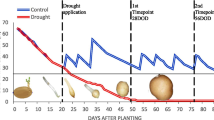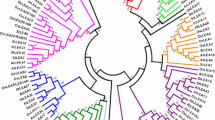Abstract
To determine their tissue-specific expression, three GRX genes were isolated from ESTs of a “6-hr post-suberization” cDNA library forSolatium tuberosum L cv. Desiree. Transcripts of a CCxC/S type GRX, StGRX1, accumulated to higher levels during the vegetative-growth stage in the leaves, stem, and roots. In contrast, transcripts of a CxxC/S type GRX, StGRX2, accumulated in the reproductive tissues, such as the flower and tuber. Differential expression of these three potato StGRXs suggest specific and unique physiological roles during plant development and in response to environmental cues. Therefore, we propose that StGRX1 is a housekeeping gene, functioning in the rapid defense against various abiotic and biotic stresses, while StGRX2 and-3 are selectively expressed during growth and in response to internal and external signals.
Similar content being viewed by others
Literature Cited
Altschul SF, Madden TL, Schäffer AA, Zhang J, Zhang Z, Miller W, Lipman DJ (1997) Capped BLAST and PSI-BLAST: A new generation of protein database search programs. Nucleic Acids Res25: 3389–3402
Alvarez ME, Pennell RI, Meijer PJ, Ishikawa A, Dixon RA, Lamb C (1998) Reactive oxygen intermediates mediate a system signal network in the establishment of plant immunity. Cell92: 773–784
Ausubel FM, Brent R, Kingston RE, Moore DD, Seidman JG, Smith JA, Struhl K (1987) Current Protocols in Molecular Biology. John Wiley and Sons, New York, Greene Publishing Associates and Wiley-Interscience
Balachandran S, Xiang Y, Schobert C, Thompson GA, Lucas WJ (1997) Phloem sap proteins fromCucurbita maxima andRicinus communis have the capacity to traffic cell to cell through plasmodesmata. Proc Natl Acad Sci USA94: 14150–14155
Beer SM, Taylor ER, Brown SE, Dahm CC, Costa NJ, Runswick MJ, Murphy MP (2004) Clutaredoxin 2 catalyzes the reversible oxidation and glutathionylation of mitochondrial membrane thiol proteins: Implications for mitochondrial redox regulation and antioxidant defense. J Biol Chem279: 47939–47951
Bernards MA (2002) Demystifying suberin. Can J Bot80: 227–240
Bernards MA, Lewis NG (1998) The macromolecular aromatic domain in suberized tissue: A changing paradigm. Phytochemistry47: 915–933
Bernards MA, Razem FA (2001) The poly(phenolic) domain of potato suberin: A non lignin cell wall bio-polymer. Phytochemistry57: 1115–1122
Cheng NH, Liu JZ, Brock A, Nelson RS, Hirschi KD (2006) AtGRXcp, anArabidopsis chloroplastic glutaredoxin, is critical for protection against protein oxidative damage. J Biol Chem281: 26280–26288
Dangl JL, Jones J (2001) Plant pathogens and integrated defence responses to infection. Nature411: 826–833
Doke N (1975) Prevention of the hypersensitive reaction of potato cells to infection with an incompatible racePhytophthora infestans by constituents of the zoospores. Physiol Plant Path7: 1–7
Fernandes AP, Holmgren A (2004) Glutaredoxins: Glutathione-dependent redox enzymes with functions far beyond a simple thioredoxin backup system. Antiox Redox Signal6: 63–74
Holmgren A (1989) Thioredoxin and glutaredoxin systems. J Biol Chem264: 13963–13966
Jacob C, Giles GI, Giles NM, Sies H (2003) Sulfur and selenium: The role of oxidation state in protein structure and function. Angewandte Chemie Intl Ed42: 4742–4758
Jeon JH, Joung H, Park SW, Kim HS, Byun SM (1992) Regulation of in vitro tuberization of potato(Solarium tuberosum L.) by plant growth regulators. Kor J Plant Tissue Cult19: 67–73
Joo JH, Bae YS, Lee JS (2001) Role of auxin-induced reactive oxygen species in root gravitropism. Plant Physiol126: 1055–1060
Kim MS, Kim HS, Kim YS, Baek KH, Oh HW, Hahn KW, Bae RN, Lee IJ, Joung H, Jeon JH (2007) Superoxide anion regulates plant growth and tuber development of potato. Plant Cell Rep26: 1717–1725
Kolattukudy R Agrawal V (1974) Structure and composition of aliphatic constituents of potato tuber skin (suberin). Lipids9: 682–691
Lemaire SD (2004) The glutaredoxin family in oxygenic photosynthetic organisms. Photosynth Res79: 305–318
Levine A, Tenhaken R, Dixon RA, Lamb C (1994) H2O2 from the oxidative burst orchestrates the plant hypersensitive response. Cell79: 583–593
Lorenzo O, Piqueras R, Sanchez-Serrano JJ, Solano R (2003) ETHYLENE RESPONSE FACTOR1 integrates signals from ethylene and jasmonate pathways in plant defense. Plant Cell15: 165–178
McAinsh MR, Clayton H, Mansfield TA, Hetherington AM (1996) Changes in stomatal behavior and guard cell cytosolic free calcium in response to oxidative stress. Plant Physiol111: 1031–1042
Minakuchi K, Yabushita T, Masumura T, Ichihara K, Tanaka K (1994) Cloning and sequence analysis of a cDNA encoding rice glutaredoxin. FEBS Lett337: 157–160
Nikkola M, Gleason FK, Saarinen M, Joelson T, Bjornberg O, Eklund H (1991) A putative glutathione-binding site in T4 glutaredoxin investigated by site-directed mutagenesis. J Biol Chem266: 16105–16112
Prasad TK, Anderson MD, Martin BA, Stewart CR (1994) Evidence for chilling-induced oxidative stress in maize seedlings and a regulatory role for hydrogen peroxide. Plant Cell6: 65–74
Razem FA, Bernards MA (2003) Reactive oxygen species production in association with suberization: Evidence for an NADPH-dependent oxidase. J Exp Bot54: 935–941
Rhoads DM, Umbach AL, Subbaiah CC, Siedow JN (2006) Mitochondrial reactive oxygen species. Contribution to oxidative stress and interorganellar signaling. Plant Physiol141: 357–366
Richberg MH, Aviv DH, Dangl JL (1998) Dead cells do tell tales. Curr Opin Plant Biol1: 480–485
Rogers SO, Bendich AJ (1988) Extraction of DNA from plant tissues. Plant Mol Biol Man A6: 1–10
Rouhier N, Gelhaye E, Sautiere PE, Brun A, Laurent P, Tagu D, Gerard J, de Fay E, Meyer Y, Jacquot JP (2001) Isolation and characterization of a new peroxiredoxin from poplar sieve tubes that uses either glutaredoxin or thioredoxin as a proton donor. Plant Physiol127: 1299–1309
Rouhier N, Gelhaye E, Jacquot JP (2002) Exploring the active site of plant glutaredoxin by site-directed mutagenesis. FEBS Lett511: 145–149
Rouhier N, Gelhaye E, Jacquot JP (2004) Plant glutaredoxins: Still mysterious reducing systems. Cell Mol Life Sci61: 1266–1277
Rouhier N, Villarejo A, Srivastava M, Gelhaye E, Keech O, Droux M, Finkemeier I, Samuelsson G, Dietz KJ, Jacquot JP, Wingsle G (2005) Identification of plant glutaredoxin targets. Antiox Redox Signal7: 919–929
Song YJ, Joo JH, Ryu HY, Lee JS, Bae YS, Nam KH (2007) Reactive oxygen species mediate IAA-induced ethylene production in mungbean(Vigna radiata L.) hypocotyls. J Plant Biol50: 18–23
Stark R, Garbow J (1992) Nuclear magnetic resonance studies of plant polyester dynamics. 2. Suberized potato cell wall. Macromolecules25: 149–154
Szederkenyi J, Komor E, Schobert C (1997) Cloning of the cDNA for glutaredoxin, an abundant sieve-tube exudate protein fromRicinus commuais L. and characterisation of the glutathione-dependent thiol-reduction system in sieve tubes. Planta202: 349–356
Xing S, Rosso MG, Zachgo S (2005) ROXY1, a member of the plant glutaredoxin family, is required for petal development inArabidopsis thaliana. Development132: 1555–1565
Zhu C, Gan L, Shen Z, Xia K (2006) Interactions between jasmonates and ethylene in the regulation of root hair development inArabidopsis. J Exp Bot57: 1299–1308
Zimmermann P, Zentgraf U (2005) The correlation between oxidative stress and leaf senescence during plant development. Cell Mol Biol Lett10: 515–534
Author information
Authors and Affiliations
Corresponding author
Rights and permissions
About this article
Cite this article
Kang, WJ., Kim, HS., Park, YI. et al. Differential Expression in Response to Biotic and Abiotic Stress from Three Potato Glutaredoxins Induced during Suberization. J. Plant Biol. 50, 663–670 (2007). https://doi.org/10.1007/BF03030611
Received:
Accepted:
Issue Date:
DOI: https://doi.org/10.1007/BF03030611




